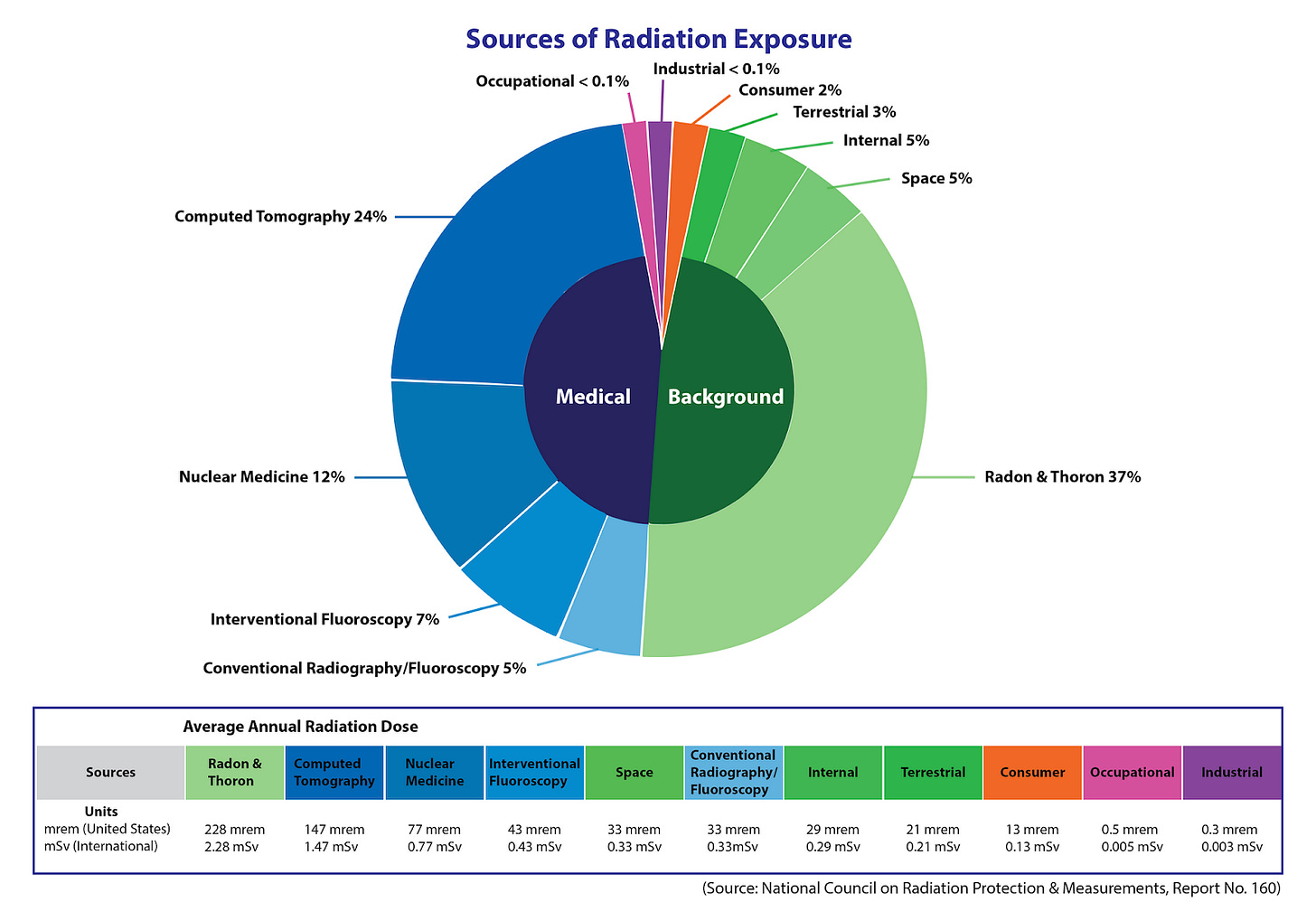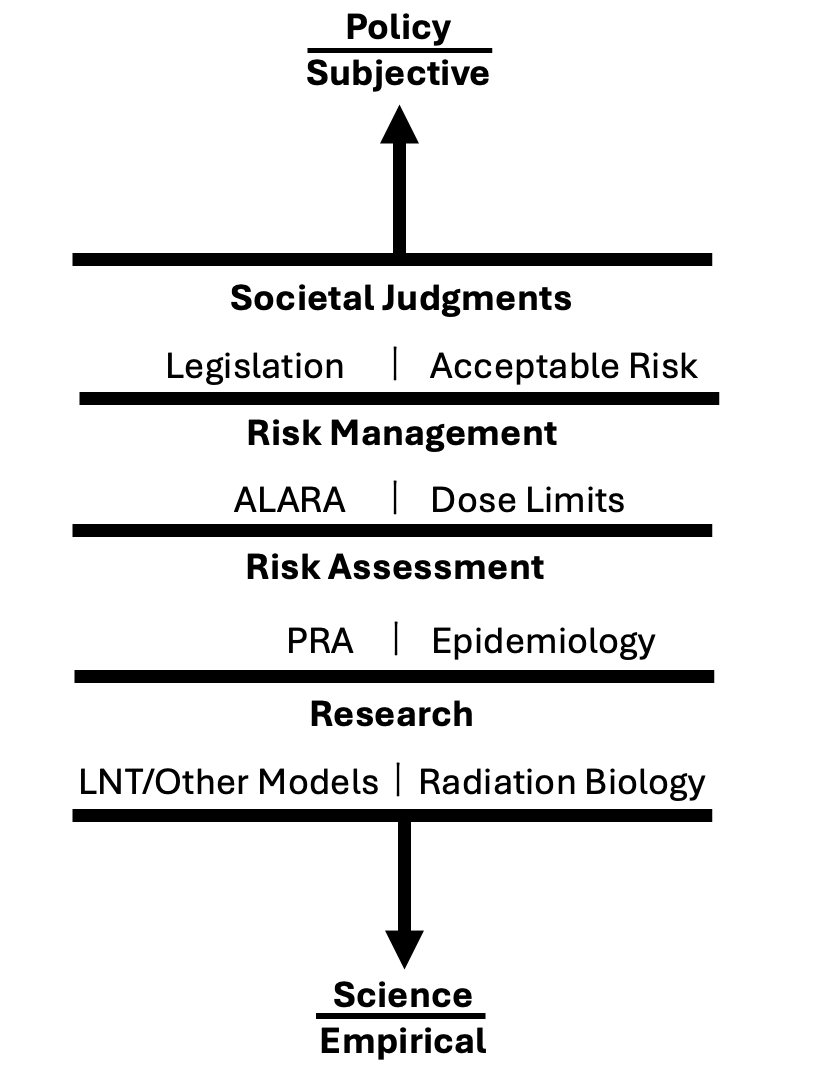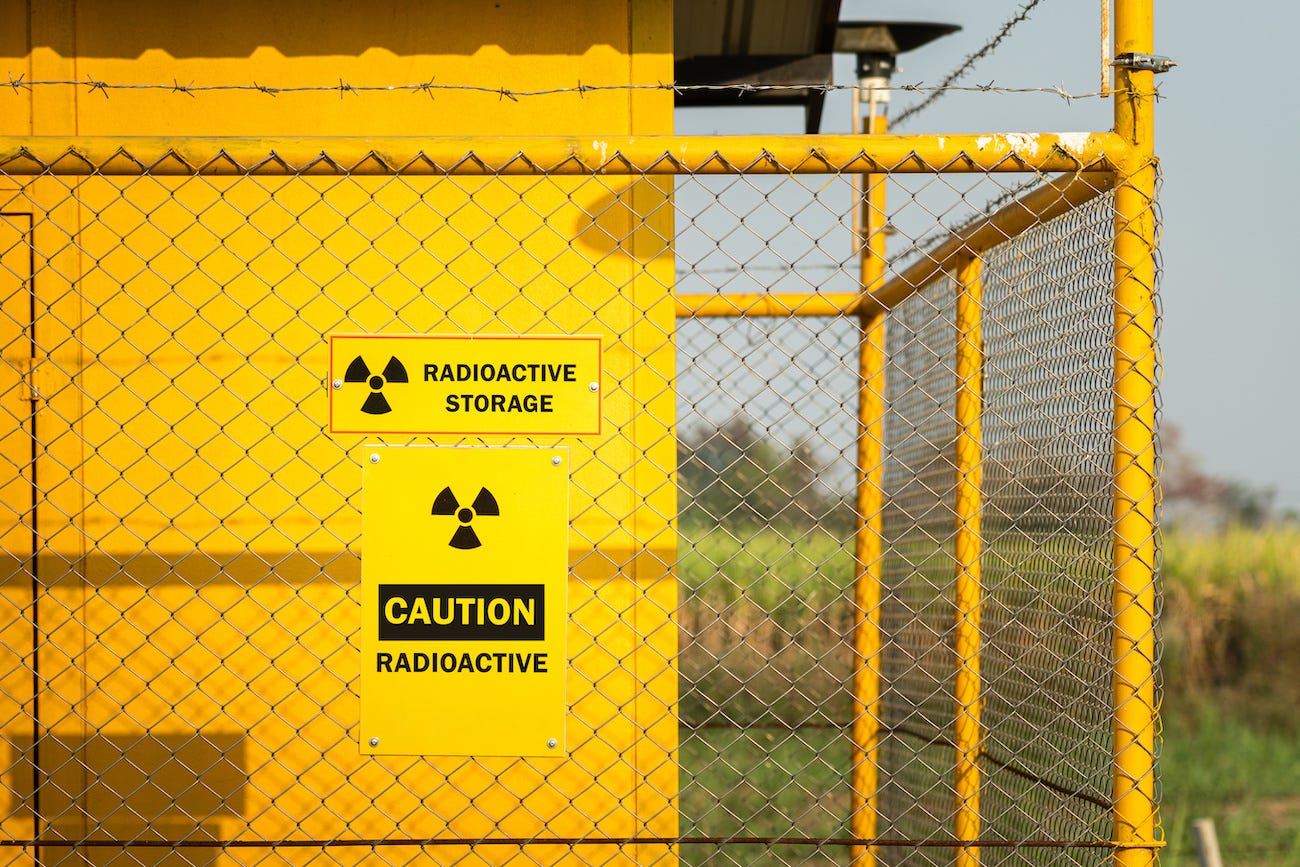How to Regulate Radiation Exposure
What is the LNT Model of Radiation Exposure Risk and How Can We Fix It
By PJ Seel and Adam Stein
It is not an everyday occurrence to see the President of the United States wade into an eight decade long debate in a niche scientific field. And yet, in an executive order announced in mid-May, the Trump administration explicitly called out the Linear No-Threshold (LNT) model of risk management as “flawed” and in need of replacement.
Linear No-Threshold might be one of the most contentious phrases in the world of nuclear science and safety. However, nuclear safety does not have a unique claim to LNT. LNT models exist throughout the safety world, applying to environmental exposures and even some chemotherapeutic drugs.
LNT models assume that there is a linear relationship between the dose or exposure to a hazard and health risks. The problem with LNT for nuclear applications is that it implies that there is no safe level of radiation, no matter how small. The LNT model, like all risk models, makes assumptions based on existing data to try to make realistic claims that insurance companies, economic planners, and public health policy makers can use. Scientific debate about using the LNT model for radiation exposure has and will continue for decades.
LNT is trans-scientific and even the International Atomic Energy Agency’s Basic Safety Standards note that LNT is “ probably not provable.” Yet, replacing LNT would require significant effort and funds over several decades, while not actually resolving the policy debate about appropriate risk levels. Instead of simply choosing a different, equally unverifiable method of determining risk, the near-term focus should be how policy and regulation manage the risk appropriately.
What is LNT?
LNT is a linear model used for estimating the risk of radiation exposure. The model is used by the U.S. Nuclear Regulatory Commission, the Environmental Protection Agency, as well as the United Nations Scientific Committee on the Effects of Atomic Radiation and the International Commission on Radiological Protection.
Regardless of what hazard you are looking at, a linear no-threshold model, by definition, is a straight line from zero exposure until the risk is 100%. The “no-threshold” part of the name indicates that there is no level above zero where a dose does not represent “risk.” A LNT model for nuclear regulation means that any amount of radiation produced by a reactor, input, or anything, is subject to oversight because, according to the model, even the smallest amount of radiation increases the risk of cancer. But, thresholds exist for pretty much every health outcome: the hot water from a tap will not burn your hand, but boiling water will.
The more hazardous the substance is, the steeper the line will be in an LNT model. A steeper line means that the health risk increases very rapidly as exposure increases. If that steep line is also linear, that means that the health risk begins increasing rapidly even with small increases from low exposures. Vaping, for example, is weakly associated with lung cancer, while cigarette smoke is strongly associated. So the slope of an LNT model for vaping would be shallower than the slope of one for cigarettes. That doesn’t mean that it is ever easy to determine the slope of the line, or to ensure it is actually straight and not curved in some way. This takes a lot of research and data to determine. In the absence of sufficient data to make that determination, public health exposure models often take the most conservative approach. Because the dose exposure relationship is much easier to observe and quantify at high doses, these models assume a linear relationship and extrapolate dose/exposure relationship observed at high doses to low doses. A linear dose/exposure model is the simplest model, and in the absence of sufficient data to observe non-linearity, the most defensible approach is to assume linearity rather than making assumptions about non-linearity or thresholds that are essentially arbitrary. For this reason, LNT is the default risk model for all environmental hazards regulated by the EPA, not just ionizing radiation.
What are Naturally Occurring Levels of Radiation?
The executive order specifically claims that the NRC uses models that “lack sound scientific basis and produce irrational results such as requiring that nuclear plants protect against radiation below naturally occurring levels.“
But, what are naturally occurring levels? The most recent comprehensive analysis found that the average background dose is 3.1 millisievert (mSv) with a standard deviation of 3.69. Negative radiation levels are not possible, but the standard deviation illustrates the wide range of background radiation levels across the US. This dose comes from many sources: radon gas permeating from the ground into the lowest level of a house, naturally radioactive potassium inside of our muscles, cosmic radiation hurtling straight through the atmosphere. Radon is the largest contributor by far (68%) and houses directly next to one another can have wildly different concentrations.

Radiation from nuclear energy is relatively easy to measure, but it's a drop in a very large bucket when it comes to radiation exposure overall. The very low levels of exposure from nuclear power are dwarfed relative to both the magnitude and variation of normal background radiation. Medically-necessary imaging contributes as much as background radiation to the entire US population, and both are more than 10,000x the dose from nuclear power. The exposure from nuclear power is so small that it doesn’t even have a separate category in Figure 1 and is instead lumped in with other industrial sources.
Radiation risk models attempt to estimate how many cases of cancer are caused by exposure to a given dose of radiation and how many subsequent deaths result. This is not easily done. Roughly 4 out of 10 people will develop cancer in their lifetimes. The causes of these cancers are incredibly varied and multifaceted. At the cellular level, all cancers result from at least two mutations, one that cuts the brakes and the other that hits the gas on cell growth. But the causes of these mutations are incredibly complex. Different genetic factors, diets, habits, and environmental exposures can cause cancers or be protective against them.
At high doses, ionizing radiation is a known carcinogen. So are many other things though—from alcohol and tobacco to viruses and industrial chemicals to seemingly benign nutrients like beta-carotene. At low doses, we are constantly exposed to so many other carcinogens, which constantly interact with so many other cancer risk factors, and cancer is so ubiquitous in the human population that quantifying cancer risk from low-dose exposure to radiation, at levels well below background radiation, is functionally impossible.
If not LNT, what else?
So, what would happen if LNT were no longer used to evaluate the risk of radiation exposure?
Well, there has to be some kind of model, and an alternative would face the same scrutiny that LNT has faced thus far, but without the benefit of decades of precedence. This could mire the NRC and EPA in years of litigation. If there weren’t a model, each exposure would have to be individually calculated for the distinctive risk to the person, which isn’t a feasible endeavor even past a few tens of people.
Presidential administrations have changed pollution limits and oversight before, but changing the paradigm of risk calculation affects the very base of safety and management practices. Starting from the ground up could yield some more efficient solution, but in all likelihood, there will just be a drawn-out fight to end at the same point.
The data on dose response can be interpreted to support many different versions or models, such as the existence of a threshold before effects begin, that low doses might be beneficial (hormesis), or even that we could be more sensitive to low doses (hypersensitivity). For example, the hormetic model is based on a select few studies of radioprotective effects that demonstrate some benefit for low doses of radiation. The fundamental idea of hormesis, though, is that because of the ubiquity of background radiation, humans and other species have evolved to live with, and in some cases, benefit from exposure to radiation.
But hormesis, or any other option, is no more provable than LNT. The range at which hormesis might exist would require even more data than LNT to prove, since the margin of benefit is smaller than the range of possible detriment. Further, lots of factors could be considered to improve the current model, such as incorporating estimates of how well DNA can be repaired at low doses or better aligning LNT with international standards, which suggest that long-term low doses only appear to be half as damaging as acute ones.
How to Improve LNT
Arguing over which model should be used isn’t a near-term solution because conclusive data isn’t currently available. Instead, the focus should be on how policy appropriately manages the risk through regulations. Risk management can be updated much more quickly to align with policy and the current state of science. In an ideal world, science is continually adjusted with increasing data and analysis. This then informs how to best assess risk and build better models. Using models allows for a defensible means of managing risk through policies and practices. These means of management are determined by what society deems permissible both through social acceptance and tangible legislative declarations.

One way that the NRC has long applied the LNT model is through the establishment of the “As Low as Reasonably Achievable” (ALARA) principle. ALARA proposes that, since there is no risk-free exposure to radiation, doses must be limited as much as is possible and economically feasible to do so. ALARA was intended to balance benefits with costs in risk-informed decisions but currently results in minimizing dose without regard to the actual amount of risk mitigated, which can lead to more harm than benefit.
In a broad sense, safety regulations try to reduce harm. If mitigating a risk is more beneficial than the costs, then it should be mitigated. For example, if a worker is performing a test and could either be exposed to a dose or avoid it altogether by leaving the area, the obvious choice is to leave the area. However, in many cases, money is being spent on reductions in dose that are unlikely to ever save a single person from getting cancer. The probability is just too low, the effect wouldn’t be observable epidemiologically if it did occur, and the LNT model is already more conservative in its risk estimation than reality.
One might consider this where the principle of what is “reasonable” should come in, but the NRC has become incredibly risk-averse and even the smallest bits of mitigation are sought.
In the 1987 decision in Union of Concerned Scientists v. NRC the court agreed with the NRC that “’Adequate protection’ is not absolute protection.” Former Commissioner Bill Ostendorff also noted that “the responsibility on us as Commissioners to decide how much risk is acceptable,” even though Congress already determined how much risk is acceptable. Despite this noted flexibility, throughout the NRC’s history the focus has been on effectively protecting the public from nuclear technologies, not enabling safe nuclear power. Keeping doses ALARA is, by rule, supposed to be countered “in relation to the utilization of nuclear energy and licensed materials in the public interest.” This has been part of the ALARA regulation for decades, but the NRC does not have a framework to compare benefits to society with perceived risk. Whereas LNT allows the NRC to make explicit and quantitative claims about risk, they have no equivalent model to quantify societal benefits like abundant electricity or reduced emissions. This is because the NRC previously held the position that considering benefits to the public was not part of its mission.
The ADVANCE Act clarified that enabling “the benefits of civilian use of radioactive materials and nuclear energy technology to society” has always been the NRC’s mission, and those benefits should not be unnecessarily limited. Regulating doses below a level that has observable health effects is an unnecessary limitation. Without a threshold under which radiation is deemed safe, the licensees need to identify every exposure, spend resources on evaluating it, provide justification for offsetting economic, environmental, or other factors, and hedge against the potential for the work to be considered insufficient by the NRC. To avoid this, licensees have to add many very small protections or safety protocols to avoid the cost of this process, even if no increase in safety is achieved. In other words, because the NRC doesn’t appropriately manage the lower range of risk, it “costs less” to add unnecessary layers of protection than not to add them.
There are many other hazards that use LNT, but the risks aren’t managed to near zero. Regulations often set reasonable thresholds on exposure to the hazard, based on acceptable risk. For example, benzene is a ubiquitous industrial chemical used throughout the world and its risks (primarily leukemia) are calculated with an LNT model. However, it is fully managed under the EPA standard of acceptable risk with standard maximum concentrations that need to be met for exposures, regardless of public or occupational status, and without the need to drive it to zero in every possible manner.
Several approaches could modernize radiation protection while working within the existing LNT framework:
Risk-informed regulation: Agencies could implement more flexible risk thresholds that better balance safety against other societal benefits, rather than adopting extremely conservative lifetime risk standards. Current implementation of ALARA principles heavily leans towards ambiguous definitions of “adequate protection” which assume risks should be near zero by default, instead of “ample margin of safety” which has quantitative definitions.
Contextual dose limits: A tiered system of radiation thresholds would reflect a reasonable balance of safety without undue burden. This includes setting a higher limit when doses under natural variation are not regulated and a slower increase when protective actions are required within the dose rates that show the highest likelihood of not being harmful. A tiered system can be implemented in the near term since it would not require a change of rule-making within both the NRC's and EPA's discretion. The first tier, up to the current public dose limit, would be exempt from regulation since it is less than the dose from someone moving from one house to another or from a low elevation to a high elevation. The second two tiers would progressively increase protection for the public and then workers. Beyond that would be an occupational limit within any one year. This both reduces regulatory burden and creates a more flexible but science-based safety regime.
Recognition of comparative risks: Despite the administration's normal defense of fossil fuels, even the executive acknowledges that “the reality that substitute forms of energy production also carry risk, such as pollution with potentially deleterious health effects.” These other risks, like particulate matter (PM) are weighed against their ubiquity, relative risk, and their emissions from industries and technologies that are otherwise beneficial for society. Regulations must consider the impact of alternatives that will be used in place, or potentially result in increasing risk from more harmful sources of energy.
LNT and Regulation Must Evolve to Meet the Regulatory Needs of the 21st Century
There are real-world costs to regulating dose rates to very low levels that pose small and very uncertain levels of risk. It involves cleaning up waste sites to levels that require decades of human labor and hundreds of billions of dollars to achieve unnecessary safety margins unlikely to save a single human life. It makes people concerned about potentially life-saving medical treatments because they imply uncertain risks. It hinders the deployment of technologies that can create small radiological exposures, even when those technologies can create real benefits for society .
Moving nuclear regulation forward doesn't require abandoning LNT as a scientific model. Instead, the NRC must pursue regulatory approaches that reflect current scientific understanding, acknowledge uncertainty, and achieve more balanced risk management. Doing so would maintain public health protection while enabling the nuclear technologies needed to address the energy security and climate goals that Congress has clearly prioritized in recent legislation.


